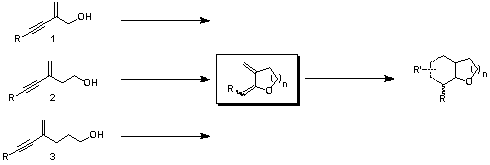ThaiREU in Organic Chemistry
Research Project Descriptions
![]()
|
Dr. Somsak Ruchirawat Chulabhorn Research Institute
|
|
In medicinal chemistry, we are interested in the
synthesis of biologically active compounds, especially nitrogen heterocycles.
Current target areas include anti-malarial compounds, isoquinolines and
the lamellarin series of natural products. A student might be involved
in the synthesis of analogs, using our already developed synthetic route,
for subsequent in-house biological screening.
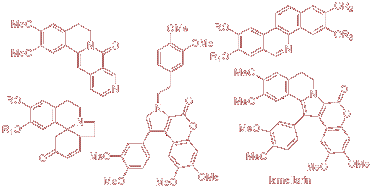
In natural products chemistry, our emphasis is
on the extraction of active natural products from indigenous Thai plants.
The work involves extraction, isolation, structural elucidation (principally
by NMR methods), and biological evaluation.
![]()
|
Dr. Poonsakdi Ploypradith Chulabhorn Research Institute |
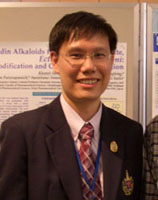 |
Our research program involves both the target-based and methodology-driven total synthesis of natural products for drug discovery. Our main objective is to develop efficient synthetic routes toward natural products ranging from chromans to pyrroloisoquinoline lactones. While natural products are an important source of medicinally and therapeutically useful scaffolds for drug discovery, the low natural abundance of biologically active compounds are the major limitation for extensive investigation. Through total synthesis, these compounds can be prepared in sufficient quantities for establishing structure-activity relationships (SARs), detailed investigation of the therapeutic indices, and for further incorporation of pharmacologically useful functional groups to provide the appropriate biological profile for drug development. Studies on their mechanisms of action also provide very useful information for developing more desirable analogues.
Our research group has been interested in lamellarins, which are
a group of marine natural products. A number of successful synthetic
routes have been developed in our group including the use of
environmentally friendly solid-supported reagents. Thus far,
over 60 structurally related analogues of lamellarins have been
successfully prepared in our laboratory and preliminary SARs
have been established. Currently, our effort has been focused
on streamlining the structural requirements of lamellarins while
incorporating functional groups to enhance aqueous solubility
and lower toxicity toward normal cells.
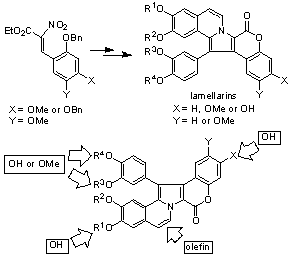
We have also developed a new synthetic methodology to prepare 2-arylchromans via the intermediacy of the highly reactive species ortho-quinone methide (o-QM). The method provides products in good to excellent yields and moderate to excellent diastereoselectivities. Our involvement in this methodology-driven total synthesis emphasizes the generation of o-QMs under mild conditions using either (1) p-TsOH immobilized on silica (PTS-Si) or (2) transition metal salts (e.g. Pt(IV) or Au(III)). Once generated, the formal [4+2]-cycloaddition reactions are investigated with a variety of appropriately activated alkenes acting as dienophiles. Both intermolecular and intramolecular modes of cyclization reactions have been studied to provide the corresponding chromans, some of which are structurally related to natural products with a wide range of biological activities.
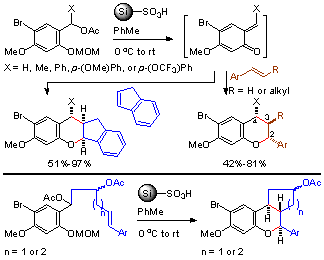
Selected Recent Publications:
1) Tummatorn, J.; Ruchirawat, S.; Ploypradith, P. A Convergent General Strategy for the Functionalized 2-Aryl Cycloalkyl-fused Chromans: Intramolecular Hetero Diels—Alder (HDA) Reactions of ortho-Quinone Methides (o-QMs). Chem. Eur. J. 2010, 16, 1445-1448.
2) Chittchang, C.; Gleeson, M. P.; Ploypradith, P.; Ruchirawat, S. Assessing the Drug-likeness of Lamellarins, a Marine Derived Natural Product Class with Diverse Oncological Activities. Eur. J. Med. Chem. 2010, 45, 2165-2172.
3) Batsomboon, P.; Phakhodee, W.; Ruchirawat, S.; Ploypradith, P. Generation of ortho-Quinone Methides by p-TsOH on Silica and Their Hetero-Diels—Alder Reactions with Styrenes. J. Org. Chem. 2009, 74, 4009-4012.
4) Tangdenpaisal, K.; Sualek, S.; Ruchirawat, S.; Ploypradith, P. Factors Affecting Orthogonality in the Deprotection of 2,4-Di-Protected Aromatic Ethers Employing Solid-Supported Acids. Tetrahedron 2009, 65, 4316-4325.
5) Chittchang, M.; Batsomboon, P.; Ruchirawat, S.; Ploypradith, P. Cytotoxicities and Structure-Activity Relationships of Natural and Unnatural Lamellarins towards Cancer Cell Lines. ChemMedChem 2009, 4, 457-465.
6) Baunbæk, D.; Trinkler, N.; Ferandin, Y.; Lozach, O.; Ploypradith, P.; Ruchirawat, S.; Ishibashi, F.; Iwao, M.; Meijer, L. Anticancer Alkaloid Lamellarins Inhibit Protein Kinases. Mar. Drugs 2008, 6, 514-527.
![]()
|
Dr. Thawatchai Tuntulani Chulalongkorn University |
|
Dr. Thawatchai Tuntulani is the coordinator of the Supramolecular Chemistry Laboratory (SML), Department of Chemistry, Faculty of Science, at Chulalongkorn University. Dr. Tuntulani’s research is focused on the synthesis of electrochemical heteroditopic anion sensors containing crown ethers or calix[4]arenes as cation binding sites and amidoferrocene as anion binding sites. The binding and detection abilities of these anion sensors in the absence and presence of alkali metal ions is then investigated by NMR, cyclic voltammetry and square wave voltammetry.
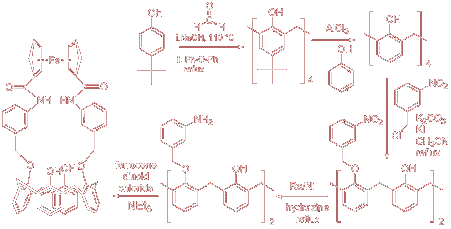
Students will prepare novel anion
sensors using the synthetic route developed in this lab, characterize
their products by 1H-NMR, 13C-NMR, elemental analysis and X-ray crystallography,
and then investigate the anion binding abilities.
![]()
|
Dr. Palangpon Kongsaeree Mahidol University |
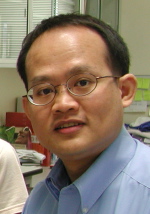 |
Dr. Kongsaeree’s lab is interested in developing new effective treatments against malaria by investigating antifolate drugs such as pyrimethamine, which inhibit dihydrofolate reductase enzyme (DHFR) at the cellular level. Structural investigation of dihydrofolate reductase-thymidylate synthase has been explored in this laboratory: the recombinant gene was cloned, the enzyme was expressed and purified to homogeneity, and the enzyme in complex with pyrimethamine was crystallized. The X-ray structure revealed the binding mechanism of the drug with atomic details. Current work is focused on elucidating the drug-resistance mechanism by studying crystal structures of mutant enzymes complexed with antifolates, leading to the development of a new generation of antifolate inhibitors.
Concurrently, new leads for antimalarials are being explored by searching
for bioactive compounds from microorganisms, especially fungi from tropical
Thailand. Fungi with promising bioactivity profiles in a preliminary screening
stage will be cultured and then using bioassay-guided isolation, pure
secondary metabolites will be obtained using chromatographic techniques
including HPLC. The chemical identity of each compound will be established
spectroscopically using NMR, IR, MS, X-ray crystallographic analysis when
possible. ThaiREU students can take part in work with mutant enzymes,
or in bioassay-guided natural product isolation and structural elucidation.
![]()
|
Dr. Thientong Thongpanchang Mahidol University |
|
Dr. Thongpanchang’s research focus is in
three main categories: 1) the development of new synthetic methodologies
towards compounds with interesting activities, 2) the design and development
of new materials and 3) physical organic chemistry in terms of the relationship
between molecular conformations and properties. He is now studying the
synthesis of arylsulfides by the addition of nucleophiles to the keto
tautomer of phenol in the presence of acid. A variety of arylsulfides
can be prepared in large quantity, as well as aryldioxins and aryldithiins,
which are important pharmacophores with possible new electro- and optochemical
materials. He is also interested in preparing highly conjugated helicenes
for new material applications using an acid catalyzed intramolecular cyclization
of binaphthols, or by photocyclization of diarylsulfides. A variety of
helicenes with key functional groups will be prepared; incorporation into
macromolecules by supramolecular assembly or via polymerization will provide
materials with interesting properties.
He is also interested in establishing the relationship between the conformation
of bonds and the properties of the molecules, especially as it applies
to the process of resolution. With camphanate ester derivatives of binaphthols
as model compounds, each diastereomerically pure material can be isolated.
Conformation analysis by means of CD / ORD and NMR spectroscopy complemented
with molecular conformation calculations as well as X-ray analyses provides
an insight into chemical bonding leading to the difference in polarity
of each diatereomeric pair on TLC. This finding can lead to an efficient
yet most straightforward method for the determination of the absolute
configuration of binaphthols.
![]()
|
Dr. Tirayut Vilaivan Chulalongkorn University |
 |
Dr. Vilaivan's main research interest concerns a new class of DNA mimic with a peptide-like backbone called "Peptide Nucleic Acid" (PNA). During the past ten years, he has designed and synthesized a number of PNA systems based on a conformationally rigid proline skeleton. Some of these PNA structures show unique nucleic acid binding properties such as exceptionally high affinity and specificity towards DNA, high preference for antiparallel binding mode, and selective recognition between DNA and RNA. Work in this area is directed towards better understanding the structural aspects of the binding and designing new PNA systems with enhanced binding properties. Their potential applications in diagnostics and therapeutics are current subjects of intensive research.
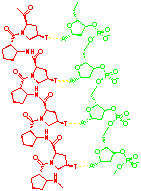 |
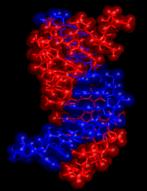 |
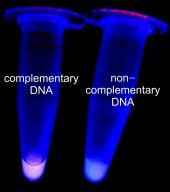 |
Dr. Vilaivan's two other major research areas are 1) development of new catalysts for asymmetric nucleophilic addition to C=N, C=O and C=C bonds, and 2) synthetic Dihydrofolate Reductase Inhibitors to be used as antimalarial drugs effective against mutant strains of maleria.
For more details please visit: http://www.chemistry.sc.chula.ac.th/personnel/details/vilaivan.htm
Representative publications:
1. Vilaivan, T.; Srisuwannaket, C. "Hybridization of pyrrolidinyl peptide
nucleic acids and DNA: Selectivity, base-pairing specificity, and direction
of binding" Org. Lett. 2006 , 8 , 1897-1900.
2. 2. Vilaivan, T.; Bhanthumnavin, W.; Sritana-Anant, Y. "Recent advances
in catalytic asymmetric addition to imines and related C=N systems" Curr.
Org. Chem. 2005 , 9 , 1315-1392.
3. . Vilaivan, T.; Winotapan, C.; Banphavichit, V.; Shinada, T.; Ohfune, Y. " Indium-mediated
asymmetric Barbier-type allylation of aldimines in alcoholic solvents: Synthesis
of optically active homoallylic amines" J. Org. Chem. 2005 , 70 (9),
3464-3471.
4. . Banphavichit, V.; Mansawat, W.; Bhanthumnavin, W.; Vilaivan, T. "A
highly enantioselective Strecker reaction catalyzed by titanium- N -salicyl- b-amino
alcohol complexes" Tetrahedron 2004 , 60 ,
10559-10568 .
5. Vilaivan, T.; Saesaengseerung, N.; Jarprung, D; Kamchonwongpaisan,
S.; Sirawaraporn, W.; Yuthavong, Y. "Synthesis of solution-phase combinatorial
library of 4,6-diamino-1,2-dihydro-1,3,5-triazine and identification of new
leads against A16V+S108T mutant dihydrofolate reductase of Plasmodium falciparum " Bioorg.
Med. Chem. 2003 , 11 , 217-224.
6. . Vilaivan, T.; Lowe, G. "A novel pyrrolidinyl PNA showing high sequence specificity and preferential binding to DNA over RNA" J. Am. Chem. Soc. 2002 , 124 , 9326-9327 .
![]()
|
Dr. Charnsak Thongsornkleeb Chulabhorn Research Institute |
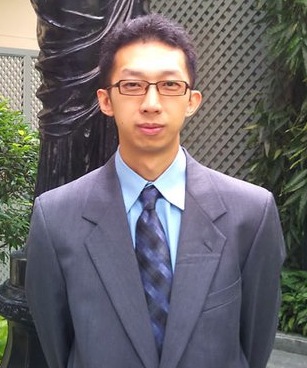 |
Heterocycles are important compounds found from many natural sources. Some of these biologically important compounds are found in nature in minute amounts; thus chemical synthesis is the best way to access enough material for further biological studies. In addition, chemical synthesis can be used to prepare derivatives which would otherwise not be available from nature.
|
![]()
Dr. Nopporn Thasana Chulabhorn Research Institute |
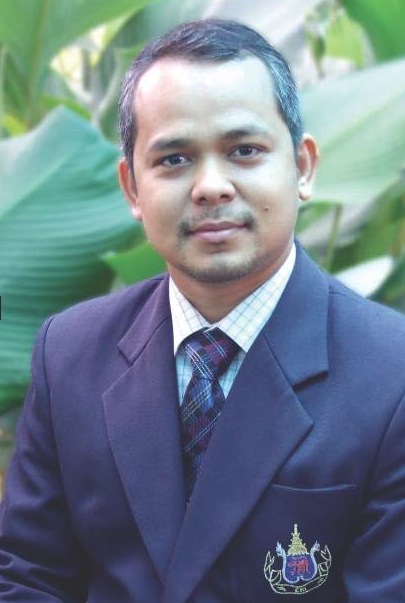 |
Dr. Thasana's research interests: Microwave-assisted organic synthesis, Organometallic chemistry, Solid-phase synthesis, Green chemistry, Synthesis of bioactive natural products
Research in Dr. Thasana’s lab focuses on the synthesis of bioactive lactones and lactams. The synthesis of various natural alkaloids and their analogues will be studied using Cu(I)-mediated microwave(MW)-assisted C-O and C-N bond formation (Figure 1). Students will study the Cu(I)-meditaed/MW-assisted coupling under “subcritical water” conditions as Green Chemistry developed in this lab.
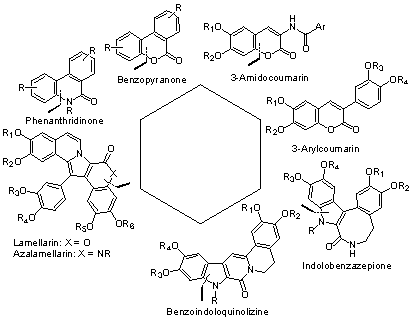
Figure 1. Syntheses of bioactive lactone and lactam derivatives
In addition, the lab is also interested in organometallic chemistry, particularly the use of organolithiums used in the synthesis of unsymmetrical benzils as applied to the synthesis of bioactive molecules:
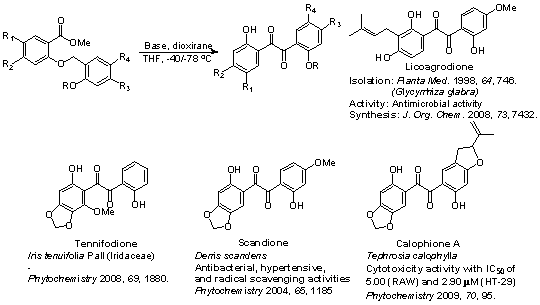
Figure 2. Synthesis of unsymmetrical benzil derivatives
Selected Recent Publications:
1) Thasana, N.; Prapagdee, B.; Rangkadilok, N.;
Sallabhan, R.; Lwin Aye, S.; Ruchirawat, S.; Loprasert, S. Bacillus subtilis
SSE4 produces subtulene A, a new lipopeptide possessing an unusual C15 unsaturated β−amino
acid. FEBS Lett. 2010, 584, 3209-3214.
2) Boonya-udtayan, S.; Yotapan, N.; Woo, C.; Bruns, C. J.; Ruchirawat, S.;
Thasana, N. Synthesis and biological activities of azalamellarins. Chem.
Asian. J. 2010, 5, 2113-2123.
3) Worayuthakarn, R.; Boonya-udtayan, S.; Arom-oon, E.; Ploypradith, P.; Ruchirawat,
S.; Thasana, N. Synthesis of unsymmetrical benzil licoagrodione. J. Org. Chem. 2008, 73, 7432-7435.
4) Thasana, N.; Bjerke-Kroll, B.; Ruchirawat, S. A facile synthesis of telisatin
A via microwave-promoted annulation and Reformatsky reaction. Synlett 2008,
505-508.
5) Thasana, N.; Worayuthakarn, R.; Kradanrat, P.; Hohn, E.; Young, L.; Ruchirawat,
S. Copper(I)-mediated and microwave-assisted Caryl-Ocarboxylic coupling: Synthesis
of benzopyaranones and isolamellarin alkaloids. J. Org. Chem. 2007, 72, 9379-9382.
6) Worayuthakarn, R.; Thasana, N.; Ruchirawat, S. Three distinct reactions
of 3,4-dihydroisoquinolines with azlactones: Novel synthesis of imidazoloisoquinolin-3-ones,
benzo[a]quinolizin-4-ones, and benzo[d]azocin-4-ones. Org. Lett. 2006, 8, 5845-5848..
![]()
